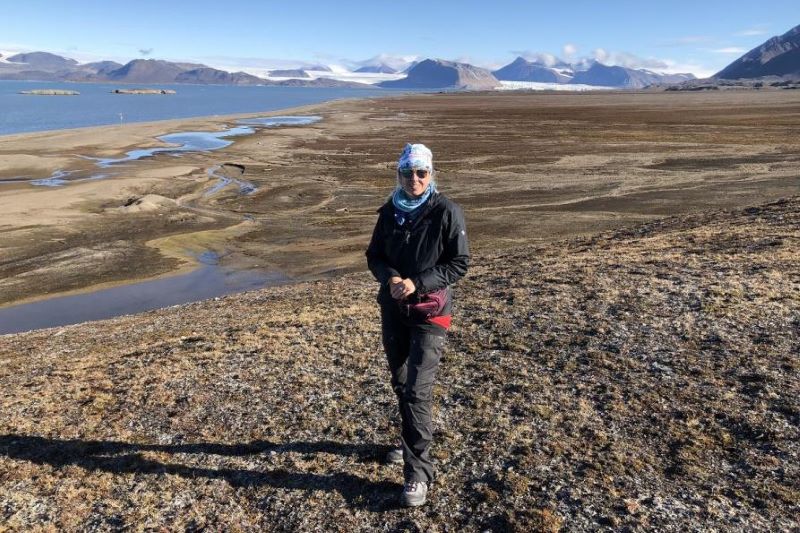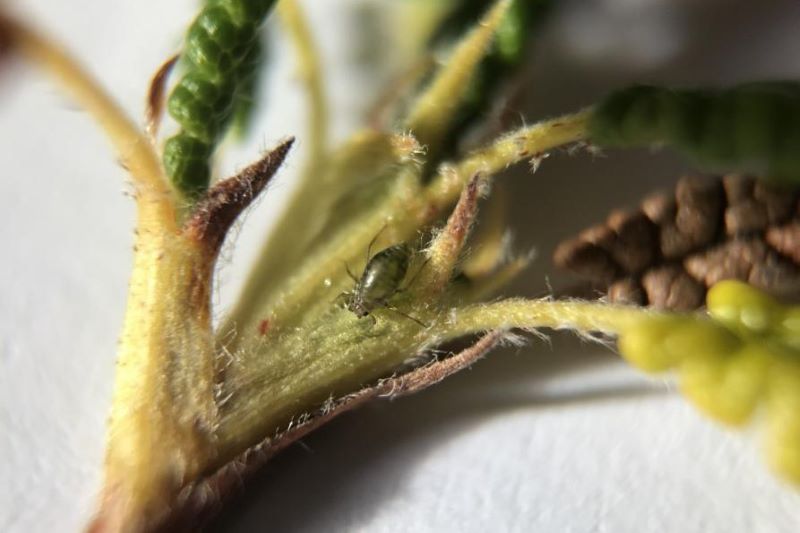Prof. Karina Wieczorek | Photo by Dominik Chłond
| Małgorzata Kłoskowicz, PhD |
There are organisms that can be found everywhere on Earth; some are even able to survive in outer space, just like tardigrades. Who would have thought that located in the polar climate Svalbard is not only inhabited by reindeer, foxes and polar bears; when you are lucky enough, you may also encounter… aphids. They reproduce and feed on host plants in order to survive similarly to our native species. Although, all the similarities end right here. What makes them special? Prof. Karina Wieczorek from the Faculty of Natural Sciences has investigated this question.
Three species from the north
‘The topic of my research is a niche area. Not many people associate polar climate with insects, let alone aphids. I, on the other hand, have been dealing with them throughout my entire professional life. And so, I’ve decided that arctic aphids may be an intriguing research subject, and I was not wrong,’ says Prof Karina Wieczorek.
The first descriptions of aphid species appeared around 300 years ago and concerned insects living in temperate zones. Three species of aphids have been identified on Svalbard so far, and it all started in the second half of the 20th century. The first species identified is Sitobion calvulum, discovered in 1958. Its subsequent morphs were described in 2003, and a vital article about parasites infecting aphids was published ten years later. A similar story of discovering Svalbard aphids concerns two other species called Acyrthosiphon svalbardicum and Pemphigus sp. Prof. Karina Wieczorek started her research in 2018, focusing her attention above all on the reproductive system of these exceptional insects from the north.
It is hard to tell how they ended up there. They have to reproduce and feed on something to survive. The biologist explains that in order to exist, they have to have a specific host plant and favourable climate conditions. Svalbard aphids are monophagous. It means a given insect species feeds on only one plant species.
‘If we tried to imagine the landscape of Svalbard, we would get something similar to mountain areas. There are no trees, but there is a tundra covered with bryophyte, lichen, and tiny herbaceous plants. It is extremely difficult to find even a single aphid in such conditions; however, we know that they are somewhere out there,’ says the researcher.
What makes them stand out is the northernmost distribution of these species. When it comes to other Arctic regions, aphids occur in far lower latitudes. At least according to our current knowledge, perhaps one day, scientists will find species inhabiting areas even further north.
The searches are tough, however, due to an extremely short period of vegetation. In Poland, the first stem mothers called fundatrices appear in March. From April onwards, their offspring—wingless or winged females produced by parthenogenesis (virgin birth)—begin to thrive to have occurred in immensely large numbers by July and August. The sexual generation of aphids that lay eggs appears not until autumn. They may be appearing even to the end of November, provided the weather conditions are favourable. Svalbard aphids are not given as much time. They may be usually observed from the middle of June to the end of August, having slightly more than two months for feeding and reproducing. They have to make haste. This distinctive lifestyle makes them hard to find, and there are no shortcuts. There has to be an expert on the spot. Gathering the material ‘by the way’ of carrying out other research is impossible. The rest is all about arduous work. There are many hours that have to be spent on your knees, gently rifling through their host plants in order to find at least one individual. It happens that nothing is found after 24 hours of hunt.
‘I visited Svalbard in late August 2018. During my intensive search, I managed to find merely 100 females and only 16 males, including three copulating pairs I barely managed to capture in time to carry out detailed analyses of male and female reproductive systems. I consider this to be a huge success,’ underlines Prof. Karina Wieczorek.
She believes that the three species native to Svalbard are somewhat exceptional. First of all, they are endemic, which means that they are found in only one region. What is more, they have specific locations they like and they can be observed only there. Our aphids are fond of the vicinity of two fjords on Spitsbergen.
The fact that the eightpetal mountain-aven (Dryas octopetala) grows there is surely not coincidental.
‘Interestingly, it is a flower that commonly grows in the mountains, for example in the Tatra Mountains. However, it is in vain to seek aphids there. It consequently means that a host plant is not enough. There have to be some additional factors contributing to a certain species of this insect having been living in a given area. Nevertheless, this is a curious scientific riddle we must yet wait to have been solved,’ admits the author of the research.
Acyrthosiphon svalbardicum, an oviparous female | Photo by Dominik Chłond
Natural enemies of Svalbard aphids
The unique location of these three species of insects is also related to a list of their natural allies and enemies. We know that in temperate zones, some species are eager to be engaged in mutualistic relationships with ants and avoid ladybirds. Things are different in the case of the Svalbard aphids. Even if ants were living there, there are no grounds for mutualism. There are, however, low temperatures and… parasites. They infect aphids by laying eggs in the insect’s body, which then becomes something similar to a mummy. With the difference that its insides are being devoured by the larvae. Prof. Karina Wieczorek admits that one might come across characteristic dry shells while searching for the research material. These are the aphids that had been eaten from within.
The only weapon aphids have in their arsenal is procreation. Prof. Karina Wieczorek explains that the differences between the way of reproduction of our local aphids and those native to Svalbard are huge.
‘Long story short, in our climate zone, the stem mother hatches from an egg in spring, and then successive generations of wingless nymphs are born. When their number increases, winged females develop and colonise other plants. This cycle lasts uninterruptedly up until autumn. Changes in photoperiod cause the female to produce sexual forms; then we can observe males and oviparous females. After copulation, adult individuals lay eggs, which survive winter, and they themselves die,’ says the researcher.
This process is different in Svalbard due to a shorter vegetation period. A fundatrice hatches from an egg and gives birth to males and oviparous females who lie eggs after copulation. This process repeats itself for approximately 1,5 months. Interestingly, it is conditioned by genetic factors and not the photoperiod. This is because, at this time, the day on Svalbard lasts 24 hours.
The reproductive system of Svalbard aphids is also noteworthy.
‘I study elements of this system together with Prof. Piotr Świątek from the USil Faculty of Natural Sciences. We already know that aphids of the Acyrthosiphon svalbardicum species have a lot of body fat. When I was dissecting the insects, the fat was oozing out of them, although it is worth mentioning that its presence has no effect on the insect’s size. The first thing that comes to your mind is obvious – the polar climate is cold and fat protects the body from low temperatures. We will check whether that is the case and it is a repetitive feature in all species of aphids on Svalbard,’ says the researcher
The other aspect of research—which has not yet been discussed in science—will be studying endosymbionts. These are bacteria, thanks to which aphids are able to digest the food they consume. Currently, we have yet no clue about what species of endosymbionts consist in the bodies of Svalbard aphids.
‘There are much more mysteries to unveil. Although I have several years of experience, I have had quite some troubles with preserving aphids of the species Acyrthosiphon svalbardicum properly to histological studies. I will try to learn what it stems from,’ admits the researcher
Aphids are certainly going to benefit from the impacts of climate change in terms of the change in their life cycle and expanding their range. ‘As I have said earlier, aphids for sure prefer quantity.’
The research project entitled Arctic aphids without mysteries – comparative studies of the structures of the reproductive system and the microbiome of endemic species of aphids found in Spitsbergen was financed within the USil Research Excellence Initiative programme.
The Aphids of Svalbard article was published in June issue No. 9 (309) of the University of Silesia Magazine







